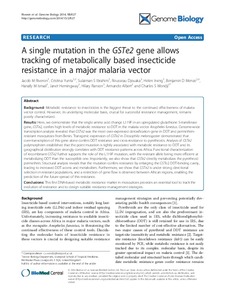| dc.contributor.author | Riveron, J. |
| dc.contributor.author | Yunta, C. |
| dc.contributor.author | Ibrahim, S. |
| dc.contributor.author | Djouaka, R.F. |
| dc.contributor.author | Irving, H. |
| dc.contributor.author | Menze, B. |
| dc.contributor.author | Ismail, H. |
| dc.contributor.author | Hemingway, J. |
| dc.contributor.author | Ranson, H. |
| dc.contributor.author | Albert, A. |
| dc.contributor.author | Wondji, C.S. |
| dc.date.accessioned | 2019-12-04T10:58:24Z |
| dc.date.available | 2019-12-04T10:58:24Z |
| dc.date.issued | 2014 |
| dc.identifier.citation | Riveron, J., Yunta, C., Ibrahim, S., Djouaka, R., Irving, H., Menze, B., ... & Wondji, C.S. (2014). A single mutation in the GSTe2 gene allows tracking of metabolically based insecticide resistance in a major malaria vector. Genome Biology, 15(2), R27. |
| dc.identifier.issn | 1465-6906 |
| dc.identifier.uri | https://hdl.handle.net/20.500.12478/983 |
| dc.description.abstract | Background: Metabolic resistance to insecticides is the biggest threat to the continued effectiveness of malariavector control. However, its underlying molecular basis, crucial for successful resistance management, remainspoorly characterized.Results: Here, we demonstrate that the single amino acid change L119F in an upregulated glutathione S-transferasegene, GSTe2, confers high levels of metabolic resistance to DDT in the malaria vector Anopheles funestus. Genome-widetranscription analysis revealed that GSTe2 was the most over-expressed detoxification gene in DDT and permethrinresistantmosquitoes from Benin. Transgenic expression of GSTe2 in Drosophila melanogaster demonstrated thatover-transcription of this gene alone confers DDT resistance and cross-resistance to pyrethroids. Analysis of GSTe2polymorphism established that the point mutation is tightly associated with metabolic resistance to DDT and itsgeographical distribution strongly correlates with DDT resistance patterns across Africa. Functional characterizationof recombinant GSTe2 further supports the role of the L119F mutation, with the resistant allele being more efficient atmetabolizing DDT than the susceptible one. Importantly, we also show that GSTe2 directly metabolizes the pyrethroidpermethrin. Structural analysis reveals that the mutation confers resistance by enlarging the GSTe2 DDT-binding cavity,leading to increased DDT access and metabolism. Furthermore, we show that GSTe2 is under strong directionalselection in resistant populations, and a restriction of gene flow is observed between African regions, enabling theprediction of the future spread of this resistance.Conclusions: This first DNA-based metabolic resistance marker in mosquitoes provides an essential tool to track theevolution of resistance and to design suitable resistance management strategies. |
| dc.format.extent | 01-020 |
| dc.language.iso | en |
| dc.subject | Insecticide |
| dc.subject | Mutation |
| dc.subject | Metabolic |
| dc.title | A single mutation in the GSTe2 gene allows tracking of metabolically based insecticide resistance in a major malaria vector |
| dc.type | Journal Article |
| dc.description.version | Peer Review |
| cg.contributor.affiliation | Liverpool School of Tropical Medicine |
| cg.contributor.affiliation | Instituto de Química-Física Rocasolano, Madrid |
| cg.contributor.affiliation | International Institute of Tropical Agriculture |
| cg.contributor.affiliation | Organisation de Coordination pour la lutte contre les Endémies en Afrique Centrale |
| cg.coverage.region | Africa |
| cg.coverage.region | West Africa |
| cg.coverage.country | Benin |
| cg.isijournal | ISI Journal |
| cg.authorship.types | CGIAR and developing country institute |
| cg.journal | Genome Biology |
| cg.howpublished | Formally Published |
| cg.accessibilitystatus | Open Access |
| local.dspaceid | 77912 |
| cg.identifier.doi | https://dx.doi.org/10.1186/gb-2014-15-2-r27 |

